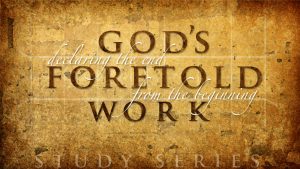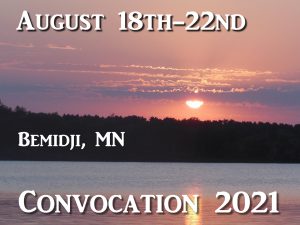I’ve had some email exchanges with my pastor, and it seems that “the imminent return of Christ” is his main objection. Also for me this scripture seems ‘against’ our view. Although it could just have been a sentence directed to the hearers that they need not concern themselves about the restoration of the kingdom, they had work to do here and now.
“And he said unto them, it is not for you to know the times or the seasons,
which the Father hath put in his own power” (Acts 1:7).So any thought would be appreciated….
I think our modern debate over the rapture question is making a very illegitimate use of the context and original intention of this passage.
So far from lending support to the doctrine of ‘imminence,’ Acts 1:6-7 is the Lord’s personal correction of that mistaken presumption.
Let’s notice some things:
The disciples that asked this question of Jesus on the eve of the Ascension were either not present when He gave the prophecy from the Mount of Olives, or they had forgotten His words. Only days before, Jesus had taught the disciples that “the end” would be preceded by an unequaled tribulation signaled by the abomination of desolation spoken of by Daniel (Mt 24:15-16, 21). But first, the gospel must be preached to all nations before the end can come (Mt 24:14).
At the time the disciples asked the question of Acts 1:6, the mystery of Christ’s twofold coming to Israel had not been revealed (Acts 3:18-21; Ro 16:25-26; 1Pet 1:11-12). They didn’t know that the risen Jesus was about to ascend to the right hand of God and there remain until His return (Acts 3:21). Even on those occasions when the disciples had heard the Lord speak of ‘going away,’ it was never imagined that this would be by way of death and resurrection and subsequent ascension.
To understand the dilemma, we must remember that the great puzzle for first century Israel was how the messianic redemption could be accomplished BEFORE and apart from Israel’s national deliverance. We know from the Jewish apocalyptic writings of the time that many looked for the redemption to follow the unequaled tribulation, or ‘Zion’s travail’ (compare Isa 66:7-8; Jer 30:6-7; Mic 5:3 with Dan 12:1), but no one knew that before this, Messiah would suffer death and be raised to return a second time. This was a mystery of the first order. It stumbled Israel. It would not come to full light until the Spirit would be poured out at Pentecost (1Pet 1:11-12).
Jesus knew that the puzzle would soon be solved when the power of the Spirit would come at Pentecost, ‘not many days from now’ (Acts 1:5). Then all would be made clear (Acts 3:18-21). But for these particular disciples at this particular time, the time for the universal witness to the gospel had come. That was the task at hand. Later, when Jerusalem’s destruction would be truly imminent, then it would be time to know that His coming is near, even at the door (Mt 24:33).
Later on, when Paul will correct a similar presumption of imminence, great stress will be laid on how the day of the Lord will be preceded and recognized by definite, known signs (Mt 24:14-15; 2Thes 2:3-4). It would therefore be a great error to interpret Jesus’ correction in a way that off sets or contradicts the great importance that He had earlier placed on reading and understanding the prophecy of Daniel (“Let the reader understand;” Mt 24:15). Jesus knew that in its time, this critical knowledge will be life or death for many (Mt 24:16, 21; Rev 12:6, 14; 13:5, 15-17).
So should this passage (Acts 1:7) be used to teach that the Lord is denying the knowableness of the time for anyone at anytime? Even pretribulationists say no. They admit that saints living at that time will surely know that the ‘end’ (i.e., the resurrection and deliverance of Israel) comes approximately 3 ½ years after the abomination (Dan 9:27; 12:11; Rev 11:2). Tribulation believers (those whom they say come to faith after the church has been removed) will surely be able to know the time when the signs appear that mark the beginning of the tribulation.
In their view, it is only believers living before a presumably imminent rapture that have no business to occupy themselves with the question of the times and seasons, since it is assumed they will be taken up before those times begin. This is how pretribulationists apply the Lord’s answer in Acts 1:7 to the question of whether anyone can know the time of the rapture and the start of the day of the Lord (i.e., “the times and the seasons;” 1Thes 5:1-2).
But the imminence of the rapture is not the question here, but the restoration of the kingdom to Israel. It is not the time of the rapture but the time of the kingdom that is not given to them to know at this time, simply because the time (and true imminence) of the kingdom cannot be known with certainty until the signs of its approach will be clearly in view.
Since the gospel must be first preached to all nations, it would have been impossible for the disciples to look for a presumed any moment rapture as a realistic potential in the earliest years before the persecution at Jerusalem (Acts 8:1), before the conversion of Paul, and before the gentile mission. Furthermore, since the final seven years begins when the Antichrist makes a false covenant of peace (Dan 8:25; 9:27; 11:23) with a recently regathered nation (Jer 30:3; Eze 38:8; Zeph 2:1-2; Dan 12:1), how can pretribulationists hold that the rapture was a truly ‘imminent’ possibility during the many centuries of Jewish exile from the Land?
Even on pretribulational assumptions, from 70 A.D. until 1948, the conditions necessary for the last seven years to begin have not been in place! Therefore, the doctrine of imminence is unsustainable for anyone committed to the necessary fulfillment of all prophecy.
As I have shown in an earlier writing (“The Rapture Question Decisively Answered by the Timing of the Day of the Lord”), the question of imminence is best decided by a study of the day of the Lord. A popular assumption that will not stand the test of scripture is that in order for the day of the Lord to come as a thief in the night, it must be secret and un-signaled. However, Paul says the day will NOT overtake believers as a thief, not because the day comes without signs, but because believers will be watching and will recognize the signs that MUST precede ‘that day’ (1Thes 5:4-6; 2Thes 2:3-4; Mt 24:15; Dan 11:21-45).
“That day shall not come except there come a falling away first and that man of sin be revealed …” (2Thes 2:3). “And I will shew wonders in heaven above, and signs in the earth beneath; blood, and fire, and vapor of smoke: The sun shall be turned into darkness, and the moon into blood, BEFORE that great and notable day of the Lord come” (Acts 2:19-20). “Behold, I will send you Elijah the prophet BEFORE the coming of the great and dreadful day of the Lord” (Mal 4:5).
In order for an event to be imminent in the sense that pretribulationists use the term, it cannot be signaled by any other known event. This is why pretribulationists were obliged to change their position on the day of the Lord, first in the 1940’s and again in the 70’s (see the above mentioned article).
Until recently, traditional pretribulationism thought the rapture started the day of the Lord. Since the day of the Lord comes unexpectedly as a thief, it was thought that it could NOT be preceded by any known event that might alert of its approach. This view became untenable when post-tribulationists of recent years pressed the point that the day of the Lord cannot be imminent until after the Antichrist has first been revealed (2Thes 2:2-3).
In order to obviate the problem, pretribulationists proposed that a gap of some indefinite duration should be discerned between the rapture and the beginning of the day of the Lord in order to provide time for the Antichrist to be revealed. This maneuver, however, is to controvert the whole idea that in order for the day of the Lord to come as a thief, it must be imminent, un-signaled, and without warning. This still popular theory collapses when definite and recognizable signs foretold in prophecy are shown to ‘necessarily’ precede ‘that day.’
Not only does scripture make clear that the Antichrist must be revealed before the Day of the Lord can start (2Thes 2:2-3), but throughout the prophets we see a number of Old Testament passages that describe the day of the Lord to be “near” or “at hand” only at the very end of the tribulation with the final judgment on the nations that have besieged Jerusalem (Isa 13:6-11; 34:8; 63:4; Eze 30:3; 39:8; Joel 1:15; 2:1; 3:14-16; Obad 15; Zeph 1:7, 14; 2:1-2; Zech 14:1).
This order of events is especially clear in Peter’s mention of the darkening of the sun and the reddening of the moon “BEFORE that great and notable Day of the Lord” (Acts 2:20), whereas Jesus, quoting the same OT prophecy (Joel 2:31), puts this climactic sign “‘immediately AFTER the tribulation of those days” (Mt 24:29-30). Therefore, if the darkness that comes BEFORE the day of the Lord is also said to come “immediately AFTER the tribulation,” it must follow that the day of the Lord is NOT the entire seven years, as in pretribulationism, but comes at the end of the great tribulation.
If the day of the Lord is NOT the seven years (the first half of which is false peace and certainly NOT great tribulation), but rather the climax of the tribulation, it becomes most untenable to argue that the day of the Lord comes without warning, or that it starts with a secret rapture, or, in more recent pre-trib theory, begins shortly after the Antichrist is revealed. This is not the language of scripture; it is pure inference based on presupposition.
As we have seen, it is false to assume that the day of the Lord cannot come as a thief if it is placed at the end of the tribulation. Even some pre-tribulational scholars admit that the coming Christ that is compared to a thief in Mt 24:43 is His visible, post-tribulational return. This is clear from the order and language of the context (Mt 24:27-43). This is further proof that preceding signs do not keep the Lord’s return from overtaking the unbelieving world as a thief.
Furthermore, Paul speaks of yet another sign of the day of the Lord that will greatly distinguish between those who will be overtaken as a thief and those who will not be surprised. It is the declaration of “peace and safety” (1Thes 5:3). I believe Paul has in mind the ill-fated peace covenant that the Jews will enter into with the Antichrist (see Isa 28:15, 18, Eze 38:8, 11, 14; 39:26; Dan 8:25; 9:27; 11:23).
To further demonstrate that the thief like day of the Lord comes at the very end of the tribulation, notice the relation of Christ’s coming as a thief in Rev 16:15 with Peter’s reference to the day of the Lord in 2Pet 3:10, 12. It is significant to observe that, according to Rev 16:15, the thief like coming of Christ is not presented as truly ‘imminent’ until after the sixth bowel.
Even so late as after the sixth bowel (Rev 16:12), the thief like return of Jesus is presented as yet future (Rev 16:15). An examination of the context of Rev 16:12-17 will show that the warning of Jesus’ thief like coming is significantly placed between the sixth and seventh bowels, and the context makes clear that the seventh bowl is “Armageddon, the battle of the great day of God Almighty” (Rev 16:14-17). This points to the fact that Jesus’ coming to destroy the Antichrist (2Thes 2:8) is the same coming that is elsewhere compared to the coming of a thief.
Notably, the next event after this insertion of warning concerning Christ’s ‘now truly imminent’ return (as a thief) is the announcement of the seventh bowel, which is also “the great day of God Almighty.” This, and not a supposed earlier rapture, is the coming that in Rev 16:15, 2Pet 2:10, 12, and Mt 24:43 is represented to overtake the ‘earth dwellers’ as a thief. In contrast, Paul makes it clear that this will NOT be the experience of the true believer. “But you, brethren, are not in darkness, so that this Day should overtake you as a thief.” (1Thes 5:4).
A careful comparison of the language of Rev 16:17 with Eze 39:8 will prove beyond question that the seventh bowl, also called “the great Day of God Almighty,” is indeed the Day of the Lord foretold by all the prophets of Israel. A further comparison of 2Pet 3:10, 12 with Rev 16:14 puts beyond question that the thief like day of the Lord and the post-tribulational “Day of God” are synonymous. Jesus comes as a thief at the great day of God Almighty to end the battle of Armageddon. This is the great and notable day of the Lord, which comes AFTER the darkness, which comes “immediately AFTER the tribulation of those days” (Mt 24:29; Acts 2:20). What could be plainer?
Hence, the term, day of the Lord, is a biblical synonym for the post-tribulational return of Christ. It is the day of Antichrist’s destruction (2Thes 2:3, 8), the gathering of Christ’s elect (Mt 24:31 with 2Thes 2:1-2), and the restoration of the kingdom to Israel (Mt 23:39; Acts 3:21; Ro 11:25-26; Rev 1:7). It does not include the tribulation; it ends the tribulation. The day of the Lord is not an imminent, un-signaled event and cannot therefore be introduced by an alleged any moment, pre-tribulational rapture. Christ returns at the day of the Lord, and this is the only return of Christ promised in scripture.
It may be asked, how can the day of the Lord come as a thief in the night when it is signaled by such clear and manifest events? That is a good question, but it leaves the question, clear and manifest to whom? It may seem a marvel, but at the time when the world will have occasion to witness perhaps the most prolific and manifest fulfillment of prophecy in history, still, the mediating angel says to Daniel, “Many shall be purified, and made white, and tried; but the wicked shall do wickedly: and none of the wicked shall understand; but the wise shall understand” (Dan 12:10).
We simply cannot suppose the Lord’s answer in Acts 1:7 is meant to teach that there is no need for knowledge of the times and events which He and Paul, and later John, so clearly sets out for the church’s protection (Mt 24:15-16, 21; 2Thes 2:4; Rev 12:6, 14; 13:5, 15-17; 14:9), and which so greatly glorifies God in the knowledge of His prophetic plan and revelation of His manifold wisdom.
The mystery revealed at Pentecost made clear that the restoration of the kingdom to Israel (i.e., the day of the Lord) must await the return of Jesus from heaven (Acts 3:21), but first “this gospel of the kingdom must be preached to all nations for witness, and then (only then) shall the end come” (Mt 24:14). The times and seasons of when that will be will only be knowable with certainty when the signs are fully in place. This concerns in particular the closing stages of Daniel’s vision, which the scripture says would not be fully unsealed and understood until the time of the end (Dan 12:4, 6-7, 9). This seems the more likely context and background of the Lord’s intention in His answer to the question of Acts 1:6.
We’ve come a long way to use a text intended to correct the mistaken presumption of imminence to defend the modern doctrine of an imminent pre-tribulational rapture. No, the day of the Lord is not imminent. It does not begin the tribulation; it ends it. It will not overtake believers as a thief, precisely because it will be preceded by the clear and knowable signs of its approach.
Finally, it would have required the greatest stretch of the imagination to teach an imminent, any moment rapture of the church at any time during the many centuries when there was no nation of Israel to even set the stage for the last seven years. The Lord is always “at hand” (Phil 4:5) in the sense that “the Judge is standing at the door” (Ja 5:9), signifying every person’s proximity to the ever present potential of sudden judgment (Lk 12:20, 45-46), but the doctrine of imminence from the standpoint of actual chronology is a disarming false doctrine that threatens to cost the church dearly.
In His precious service, Reggie




